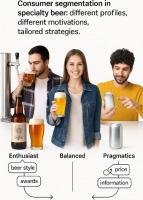Consumer perception and label evaluation of craft beer in Brazil: A mixed-method study on preferences, packaging, and purchase drivers
IF 8.2
Q1 FOOD SCIENCE & TECHNOLOGY
引用次数: 0
Abstract
The craft beer market has been rapidly expanding worldwide, driven by consumer demand for unique sensory experiences, authenticity, and distinctive packaging. However, limited evidence exists on consumer perceptions in Latin America, particularly in Brazil, where the sector has grown significantly in recent years. This study aimed to characterize Brazilian craft beer consumers and evaluate their perceptions of label and packaging attributes through a mixed-methods approach. A quantitative survey was conducted between March 2024 and May 2025 with 90 respondents, followed by three focus groups (26 participants) in November and December 2024. Survey results revealed a predominantly young, educated, and male profile, with frequent consumption of specialty beers and diverse preferences regarding styles, price, and packaging formats. K-Means clustering and PCA identified three consumer segments: Enthusiasts (38%), who value authenticity, premium styles, and detailed packaging; Balanced (40%), who integrate style and price considerations, favoring modern and informative labels; and Pragmatics (22%), who are more price-sensitive and prefer minimalist packaging. Focus group discussions reinforced these clusters and highlighted three major drivers of purchase intention: clarity of label information, visual identity and storytelling, and alignment with consumer values such as authenticity and accessibility. Practical implications include the need for breweries to design differentiated packaging strategies for distinct consumer segments, while theoretical contributions advance knowledge of consumer behavior in emerging craft beer markets. Limitations of sample size and representativeness suggest avenues for future research.

巴西精酿啤酒的消费者认知和标签评价:偏好、包装和购买驱动因素的混合方法研究
由于消费者对独特感官体验、真实性和独特包装的需求,精酿啤酒市场在全球范围内迅速扩张。然而,关于拉丁美洲消费者观念的证据有限,特别是在近年来该行业增长显著的巴西。本研究旨在描述巴西精酿啤酒消费者的特征,并通过混合方法评估他们对标签和包装属性的看法。在2024年3月至2025年5月期间,对90名受访者进行了定量调查,随后在2024年11月和12月进行了三个焦点小组(26名参与者)。调查结果显示,主要是年轻人,受过教育的男性,经常消费专业啤酒,对款式,价格和包装形式有不同的偏好。k均值聚类和PCA确定了三个消费者群体:发烧友(38%),他们重视真实性、高级风格和详细的包装;平衡型(40%),他们将风格和价格考虑在一起,喜欢现代和信息丰富的标签;实用主义者(22%),他们对价格更敏感,更喜欢简约的包装。焦点小组讨论强化了这些集群,并强调了购买意愿的三个主要驱动因素:标签信息的清晰度,视觉识别和故事叙述,以及与消费者价值观(如真实性和可访问性)的一致性。实际意义包括啤酒厂需要为不同的消费者群体设计差异化的包装策略,而理论贡献则推进了新兴精酿啤酒市场中消费者行为的知识。样本量和代表性的局限性为未来的研究提供了途径。
本文章由计算机程序翻译,如有差异,请以英文原文为准。
求助全文
约1分钟内获得全文
求助全文
来源期刊

Future Foods
Agricultural and Biological Sciences-Food Science
CiteScore
8.60
自引率
0.00%
发文量
97
审稿时长
15 weeks
期刊介绍:
Future Foods is a specialized journal that is dedicated to tackling the challenges posed by climate change and the need for sustainability in the realm of food production. The journal recognizes the imperative to transform current food manufacturing and consumption practices to meet the dietary needs of a burgeoning global population while simultaneously curbing environmental degradation.
The mission of Future Foods is to disseminate research that aligns with the goal of fostering the development of innovative technologies and alternative food sources to establish more sustainable food systems. The journal is committed to publishing high-quality, peer-reviewed articles that contribute to the advancement of sustainable food practices.
Abstracting and indexing:
Scopus
Directory of Open Access Journals (DOAJ)
Emerging Sources Citation Index (ESCI)
SCImago Journal Rank (SJR)
SNIP
 求助内容:
求助内容: 应助结果提醒方式:
应助结果提醒方式:


